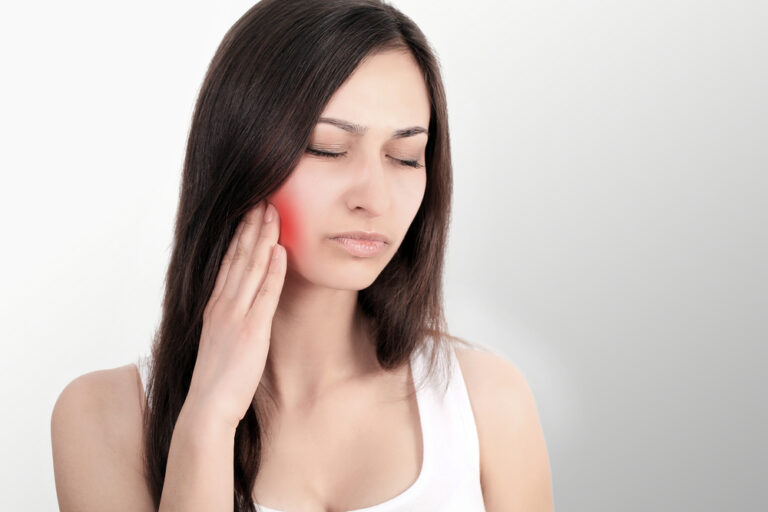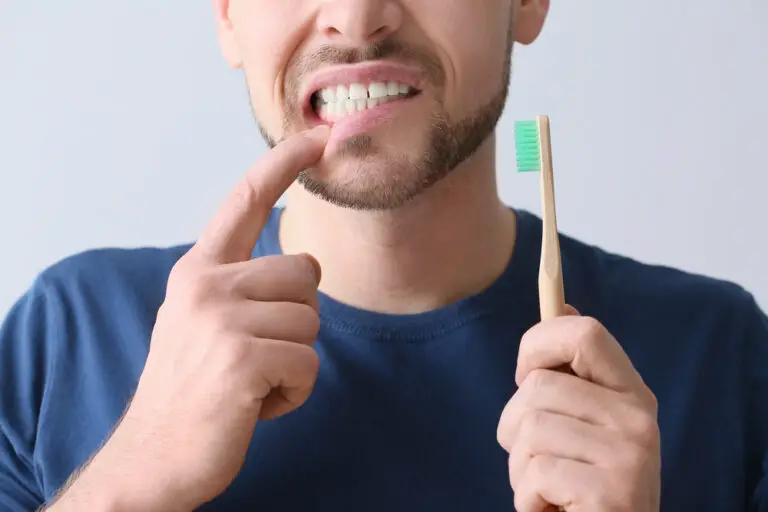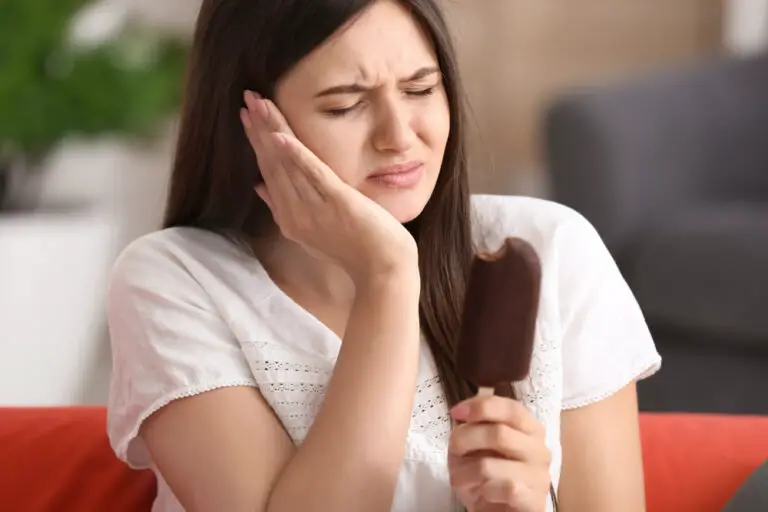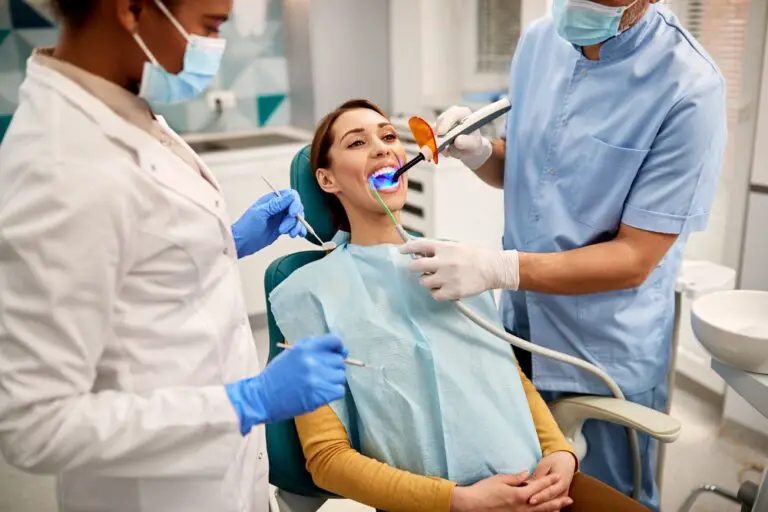After enduring months or years of wearing fixed braces or other orthodontic appliances, it’s exciting to finally have straight, properly aligned teeth. However, upon brace removal, some patients are disappointed to see their teeth looking more yellow or stained than before treatment.
Discolored teeth after orthodontics is an unfortunate but common occurrence. Even teeth that were sparkling white at the start of treatment can emerge dingy and dull.
This jarring color shift understandably alarms those who expect gleaming results after their intensive orthodontic process. But don’t dismay – with the right strategies, you can return your post-braces smile to its former glory.
In this detailed guide, we’ll cover:
- The main reasons teeth discolor from braces
- Preventing yellowing during orthodontic treatment
- Different methods to brighten teeth after braces
- How to protect whiteness long-term after whitening treatments
- When to see a dentist about post-braces stains
What Causes Teeth Staining After Braces?
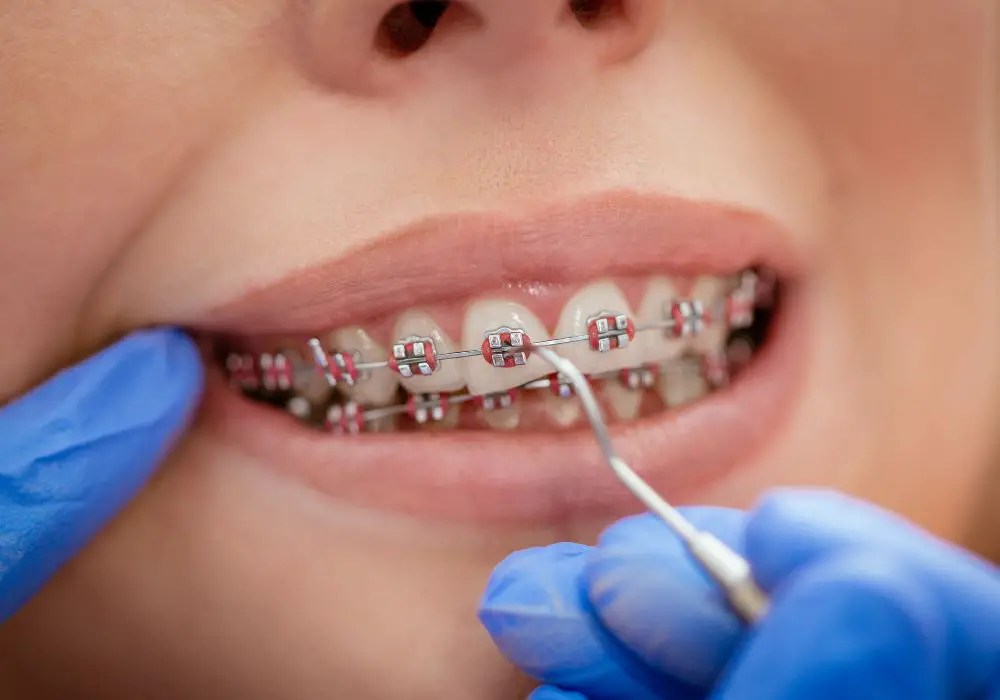
Why do teeth that look so pearly at the start of orthodontic treatment sometimes emerge from braces looking like a faded, yellowed version of their former selves? There are a few primary culprits.
Enamel Damage
The constant pressure and friction from orthodontic appliances can damage the enamel – the outer mineralized layer that protects the teeth. This damage makes teeth more prone to staining and discoloration in the following ways:
- Micro-fractures in enamel from brace force – Years of steady orthodontic pressure can cause tiny cracks, chips, and fissures in the enamel surface. These defects create pores and pathways where stains can more readily penetrate into the subsurface.
- White spot lesions/decalcification – When plaque is left on teeth under brackets or bands, the acid from bacteria eats into the enamel, leaching out minerals. This results in white, chalky patches called decalcification or white spot lesions. The demineralization makes enamel weaker and more stain-absorbent.
- Chemical etching – The glue used to adhere brackets to the teeth can penetrate into the microscopic pores of the enamel. Over time, the chemicals in the adhesive can oxidize and darken, causing intrinsic discoloration underneath the enamel layer.
Plaque Accumulation
The fixed braces themselves provide the ideal environment for plaque to accumulate and thrive. Food particles easily get lodged between wires, brackets, bands and ties. Without diligent cleaning, this debris attracts harmful bacteria to form a film called plaque.
Some of the bacteria produce pigments that cause extrinsic staining on tooth surfaces. Plaque also releases acids that degrade tooth minerals and cause cavities or white spot lesions.
The textured metal surfaces of braces provide the perfect sticky surface for plaque to adhere strongly, resist brushing, and proliferate. Studies show fixed appliances increase plaque levels by 2-3 times compared to the pre-braces baseline.
Left undisturbed, plaque matures into harder calculus or tartar that entraps more stains over time. This sticky tarter requires professional dental cleaning to remove once hardened.
Dietary Stains
With their brackets, wires, and rough surfaces, braces are magnets for trapping food particles and beverage stains, especially in hard-to-access areas. Some common dietary culprits include:
Dark sodas or sports drinks: The phosphoric acid and carbonation wear away enamel and help dark pigments penetrate subsurface.
Coffee and tea: These contain deep-hued tannins that latch onto plaque.
Wine, berries, and other dark liquids: Intensely pigmented fluids can seep into compromised enamel around appliance edges.
Tobacco: Smoking, chewing tobacco, and vaping cause brown build-up. The nicotine also yellows any adhesive resin.
Sugary foods feed plaque bacteria whose byproducts dig into the enamel. Without prompt brushing, stains have ample time to set on weakened enamel after eating or drinking.
How to Prevent Yellowing During Orthodontic Treatment
Preventing dental stains during orthodontics takes dedication, but it helps ensure teeth stay bright for the reveal after braces come off. Here are some useful tips:
- Brush carefully and thoroughly around all brace surfaces after each meal and snack, taking extra time to clean every angle. Use a soft-bristled brush or orthodontic toothbrush designed to maneuver around appliances.
- Floss carefully between all contact points of teeth, wires, and brackets at least once per day. Floss threaders help guide floss under the wires.
- Use a fluoridated mouthwash daily to reduce bacteria levels. Select an alcohol-free formula to avoid dryness. Swish vigorously to penetrate under wires and brackets.
- Apply protective dental sealants to vulnerable spots at risk for decay or white lesions. Make sure to get sealants replaced if they wear off.
- Request plastic or ceramic instead of metal brackets and wires if possible to combat staining on enamel. However, seek professional cleaning every 3 months to combat plaque on any brackets.
- Eliminate all tobacco products from the diet, including smoking, vaping, and chewing tobacco. Avoid smoking immediately before adjustment visits.
- Limit staining foods and beverages or promptly brush after consuming them. Drink dark liquids through a straw placed toward the back of the mouth.
- Keep strict 6-month professional cleaning appointments to remove hardened plaque and stains. Request topical fluoride applications to strengthen enamel.
- Ask your orthodontist about options for lingual (behind the teeth) braces to limit food-staining risks on front surfaces. However, oral hygiene is still crucial with inside braces.
Staying diligently on top of oral hygiene, diet, and professional cleanings helps prevent yellowing and protects teeth during orthodontics. However, some amount of discoloration after braces is normal. The good news is that stains acquired during braces generally can be removed through various whitening techniques.
Methods to Brighten Teeth After Braces
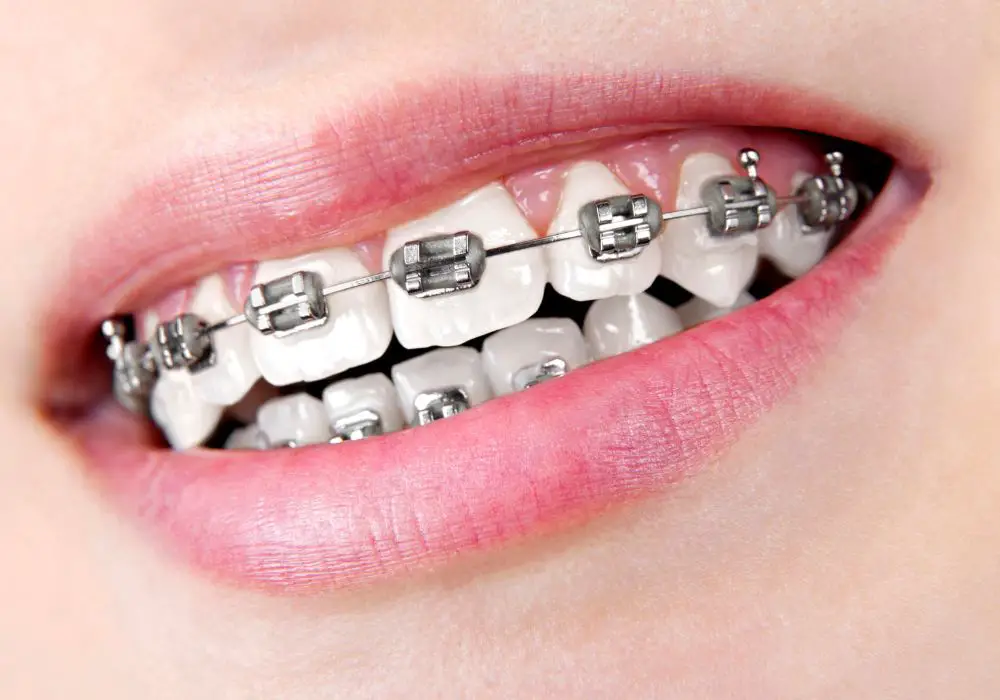
If your teeth look more yellow after your braces come off, don’t panic! There are several effective options to brighten your smile. The method chosen depends on the severity of staining and your time and budget constraints.
Over-the-Counter Whitening Products
For mild discoloration, oral care aisles offer many affordable at-home whitening products to gently brighten teeth a few shades lighter. These typically use mild concentrations of hydrogen or carbamide peroxide as the active whitening agent.
Popular options include:
- Whitening Toothpastes: Contain polishing agents like baking soda or hydrated silica for surface stain removal, plus low-dose peroxide for mild bleaching. Use as regular daily toothpaste.
- Whitening Rinses: Swish lightweight peroxide formula around teeth to lift stains and instantly freshen breath. Use daily after brushing.
- Whitening Gums and Strips: Apply strips coated in peroxide gel onto teeth for 30-60 minutes daily. Chew gums briefly to release gentle peroxide.
- Tray-Based Gels and Pens: Use a small brush or pen to paint higher concentrate peroxide onto teeth, then place trays molded to teeth to hold gel in contact for 20-30 minutes or overnight.
Over-the-counter options gradually lighten teeth a few shades over 2-4 weeks with regular use. They are affordable and accessible, but provide mild brightening compared to professional options. Maintain by using 1-3 times per week.
In-Office Whitening Treatments
For more dramatic whitening in one visit, dentists can perform supervised in-office bleaching sessions. Options include:
- In-Office Laser Whitening: Apply concentrated peroxide gel to teeth and enhance action with light or laser energy. Effects are seen after 1 visit lasting an hour or less.
- Power Bleaching: Use a stronger concentration peroxide agent along with light and occasionally heat to accelerate bleaching. May require several visits for maximum effect.
Dentist-administered treatments produce significant whitening of multiple shades in a short period. However, they cost more per session than at-home methods and increase sensitivity risk. Space out professional sessions every 4-6 months to avoid over-whitening effects.
Custom-Fit Whitening Trays
Dentists make personalized trays that fit precisely over teeth and are filled with a peroxide-based gel. Wear the trays with fresh bleaching gel for prescribed time periods at home over 2-4 weeks. Trays allow close contact for uniform whitening across all teeth.
For mild touch-ups between sessions, your dentist may provide syringes of higher concentration whitening gel to place in the trays at home on an as-needed basis. Take care not to overuse strong gel without supervision.
Custom trays produce better whitening than strips for similar peroxide concentrations since gel contacts all tooth surfaces thoroughly. Trays cost more initially but then allow inexpensive at-home touch-up bleaching.
Veneers and Dental Bonding
For localized spots or cases of severe intrinsic staining that resist bleaching, cosmetic treatments like veneers and dental bonding can mask discoloration and reshape teeth.
Veneers are thin porcelain facades that adhere to front tooth surfaces to create ideal color, shape, and symmetry. Veneers last many years but require permanently removing some natural tooth structure.
Bonding applies tooth-colored composite resin material directly onto the tooth surface. Dentists sculpt it with light curing to mask flaws and improve color with a minimized invasive footprint. However, bonding stains over time and requires occasional replacement.
These options provide immediate, dramatic tooth color improvement but at higher cost. They also permanently alter the natural teeth, so first consider minimally invasive bleaching techniques.
How to Preserve Whiteness After Teeth Whitening
After investing time and money into teeth whitening treatments, maintaining results involves diligent oral care and lifestyle habits.
Oral Hygiene
- Brush teeth thoroughly twice daily with a soft or powered toothbrush. Take extra time accessing hard-to-reach spots around dental work.
- Floss once daily to clear plaque between teeth and around restorations. Interdental cleaners also help remove debris.
- Use whitening or desensitizing toothpaste daily along with mouthwash to control bacteria.
- Get professional cleanings and exams every 6 months to catch plaque buildup early. Request topical fluoride to reinforce enamel.
Diet and Lifestyle
- Drink staining beverages through a straw placed toward the back of the mouth to minimize contact with front teeth.
- Rinse mouth with water after consuming chromogenic foods and drinks.
- Limit snacking frequency, choosing tooth-friendly options like cheese over sugary treats.
- Avoid habits like smoking, chewing tobacco, lip biting, and nail chewing that stain teeth.
- Stay hydrated by drinking plain water throughout the day and chewing sugarless gum to stimulate saliva flow.
By being proactive with at-home care, diet, and professional cleanings, you can keep your bright post-whitening smile glowing for years to come. Avoid overusing bleaching products in chase of unrealistic levels of whiteness. Moderation helps maintain natural enamel integrity.
When to See the Dentist for Post-Braces Stains
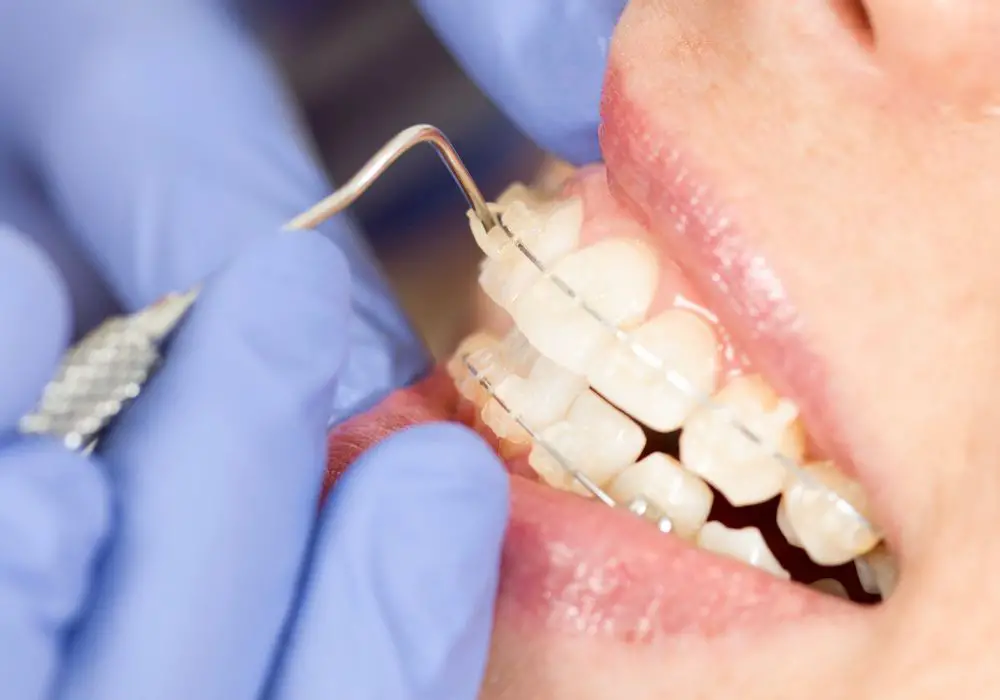
While over-the-counter methods can improve mild yellowing, some situations call for an office visit:
- Severe intrinsic stains affecting inner tooth layers that resist surface bleaching. The cause needs investigation to rule out dental trauma, nerve damage, or underlying decay.
- White spots or demineralized enamel that turn opaque and don’t respond to fluoride treatment. May require veneers or restoration.
- Suspected recurring decay around old fillings or veneers that may need replacement.
- Generalized darkening across multiple teeth indicating dental neglect, enamel issues, or side effects of medications/illness.
- Unnatural uniform whiteness or opacity signaling overuse of whitening products.
- Sensitivity or gum irritation persisting for several days after bleaching treatment.
For moderate or severe discoloration with an unclear etiology, seek professional guidance. Dentists have access to stronger in-office treatments and can diagnose any underlying factors causing stubborn stains or sensitivities. With the right game plan, they can help you smile confidently after orthodontic treatment.
Frequently Asked Questions
Q: Why are my teeth yellow with white spots after braces?
A: White spot lesions or decalcification commonly occurs under brackets during orthodontics when plaque is not well controlled. The areas under the brackets become weakened by acid and lose minerals, looking opaque and chalky. Although unsightly, the white spots merely indicate enamel damage, not active decay. However, their porous nature makes them more prone to collecting stains. Stopping the decay process through good hygiene and fluoride is key, but the white lesions themselves are irreversible enamel defects. Several options including micro-abrasion, resin infiltration, dental bonding or porcelain veneers can mask their appearance by blending them into surrounding enamel.
Q: How can I make my teeth whiter at home after braces?
A: There are several convenient at-home options to gradually brighten teeth over 2-4 weeks of daily use:
- Whitening toothpaste with gentle polishers like hydrated silica
- Whitening rinses to use as a daily mouthwash
- Adhesive whitening strips coated in mild peroxide gel
- Custom bleaching trays from the dentist filled with peroxide gel
- Brush-on whitening pens applied in trays or directly to teeth
- Non-abrasive whitening gums that release peroxide when chewed briefly
Q: Why are my teeth sensitive after whitening?
A: Common side effect of peroxide bleaching agents is increased sensitivity. Peroxide can temporarily irritate the nerves inside teeth, making them more reactive to hot and cold. Using gel with lower peroxide concentrations, limiting frequency to 2-3 times per week, and taking breaks from whitening can help. Desensitizing toothpaste also helps nerves calm down faster. Stop use and see a dentist if sensitivity lasts more than 3-5 days after whitening.
Q: How white should I realistically aim for with my teeth?
A: Avoid the temptation to over-whiten teeth to an opaque, fluorescent white that looks artificial. Try to lighten just enough shades to remove intrinsic stains and restore teeth to their naturally brighter shade. Whiteness levels should blend pleasingly with your skin tone. Moderation prevents over-drying enamel and nerve damage. If correctly whitened teeth still seem too dingy against skin, seek professional advice on cosmetic options. But remember perfection is not the goal – a healthy, vibrant smile is.
Q: How often can I get my teeth professionally whitened?
A: Most dentists recommend professional in-office whitening no more than 2-4 times per year, as peroxide can accumulate in teeth over time and cause inflammation. Allow at least 2 weeks between whitening sessions for sensitivity to resolve. For mild touch-ups in between, use custom trays with over-the-counter whitening gel 1-2 times per month. Avoid chasing the “whitest white” and focus on reasonable stain removal.
Conclusion
A few shades of off-white discoloration after braces removal is common and nothing to worry about. Diligent oral hygiene helps curb major staining, but some yellowing occurs from the conditions braces create in the mouth. Don’t hesitate to ask your orthodontist for whitening advice even before appliances come off.
While post-braces teeth may not emerge camera-ready, know that you have many conservative options to gradually return your smile to its former luster. With patience and persistence, a glowing, healthy smile can shine through.


